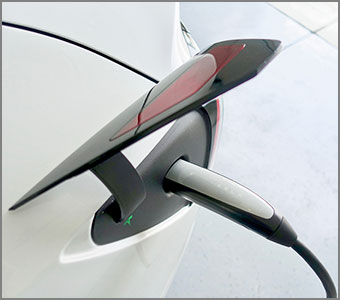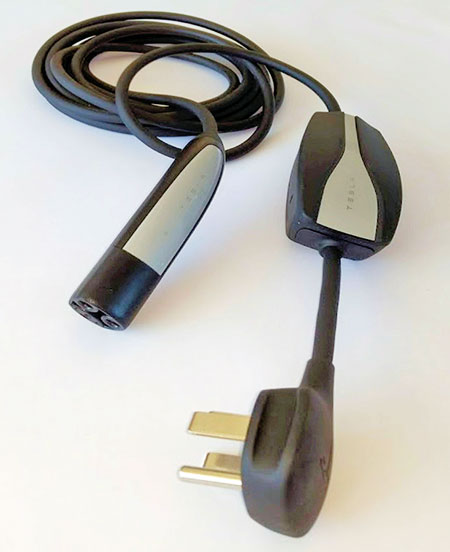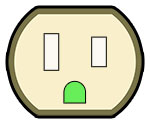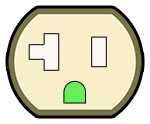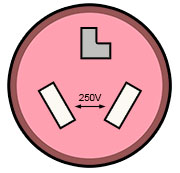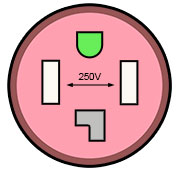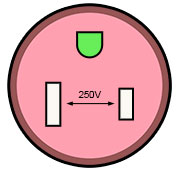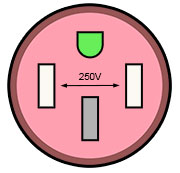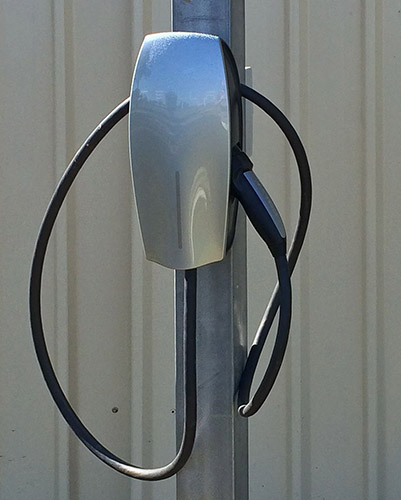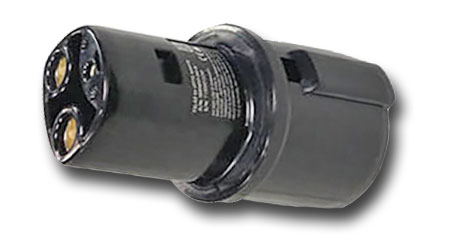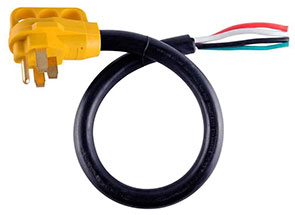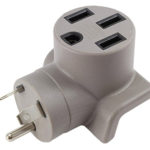Charging your Model 3/Y at home is different from charging on the road. On-road trips your time is limited, and you want the fastest charge possible. Since a personal home Supercharger costs more than a car, you can take advantage of the fact that charging at home can be done at a more leisurely speed… often overnight while you sleep.
As a reference, a Supercharger can charge a car up to 1000 miles per hour. Destination Chargers at hotels can charge a car with a long-range battery at up to 44 miles of range per hour, while a Model 3 with a standard-range battery can charge at up to 30 miles of range per hour. At home, you have the flexibility to charge your car at Destination Charger speeds as well, or you can typically charge as slow as 5 miles of range per hour from a standard 120-volt electrical outlet… or somewhere in between utilizing various types of outlets.
We’ll help you choose the best charging solution based on:
- Number of miles per day the car is typically driven
- The existing electrical infrastructure where the car is parked and the costs to upgrade to a higher amperage circuit if needed
- Future-proofing: Consider the need to charge additional Tesla vehicles or non-Tesla EVs
Number of miles per day the car is typically driven
This is the primary consideration. What goes out must go back in. An easy calculation determines the outlet required, or if you would benefit from a dedicated charging device such as a Tesla Wall Connector, which is capable of higher charge rates. To calculate the required charging speed, note the highest number of miles you might drive your car on a given day. Then you just divide that number by the number of hours available to charge the car. For example, if your commute is 50 miles, and the car is parked at home for 12 hours, divide 50 by 12. The result is 4.2. That means your charging solution should add at least 4.2 miles of range per hour to the car. Simple. Naturally, that is a minimum. You are free to install a charging solution of any capacity above that to act as a buffer, or for those times you drive extra distances.
There is one consideration that may affect the number of hours available to charge the car. If your utility company offers discounted rates for EV charging you may wish to charge only during the lowest cost rate period. EV rates and schedules vary among utilities, but let’s take the same example above and assume your utility allows for EV charging at discount rates between Midnight and 6 AM. That’s a six-hour window, so divide 6 into 50. That equates to a required charging rate of 8.3 miles of range per hour. Your charging solution now must provide twice the current to fully charge the car at the preferable rates. The calculator below helps you find your ideal charging speed.
Cold Weather Adjustments
Throughout this article, we assume the car is not charging in freezing weather. The battery pack does not charge if its internal temperature is too low and may require heating the battery. The process is automatic if needed. This heating reduces the charging rate by 2-4 miles range per hour. If you expect to charge in freezing weather, consider this. In extreme cold, charging at 120V may only keep the battery heated and may not add any additional miles of range!
| Typical daily miles driven |
Charging start time | Charging end time | Charging speed (miles of range per hour) |
Minimum NEMA Outlet |
|---|---|---|---|---|
Existing electrical infrastructure and costs to upgrade to a higher amperage circuit if needed.
Now that you have determined the number of miles of range per hour you wish to put back into your car each day, you need to determine the electrical service required to plug the car into. Keep in mind that the charge cord that comes with the car (the Mobile Connector Gen 2) is 20’ long. Ideally, the outlet should be close enough to the charge port on the car (left rear) to use the Mobile Connector. The optional Tesla Wall Connector includes a 24’ cable.
All but the lowest charging rates are going to require a 240V circuit. A standard 120V can be used to charge the car, but as you can see in the chart below, charging is limited at best to around 7 miles of range per hour (a.k.a. trickle charging).
Many charging solutions take the form of using the included Mobile Connector plugged into some type of wall outlet, but if you wish to charge your car with the Long-Range battery at the fastest speed that the car’s onboard charger can handle, a hard-wired Electric Vehicle Supply Equipment (EVSE) is required. An EVSE is simply the connection between the car and the power source, such as the Mobile Connector, but a hard-wired EVSE is usually connected directly to an electrical panel and can provide more current than any outlet is capable of. In the case where the maximum charge rate for the LR is desired, the ideal solution is the optional $400 Tesla Wall Connector (the SR Model 3 can charge at full speed from a 6-50 or 14-50 outlet). Third-party hard-wired EVSE devices are available, but few compete with the Tesla Wall Connector on price, nor are most capable of charging the LR battery at maximum speed (a 60-amp capable EVSE is required).
After consulting the chart below consider how far your electrical service is from where you park your car. Check if there is room for an additional 240V breaker (usually 2 slots). Is it necessary to run wiring from the main panel to where the car is parked? Is the total service at the main panel adequate? Older homes often have 100-amp service, which may require upgrading for higher power outlets.
The costs to upgrade the electrical infrastructure can run from a few hundred dollars to several thousand dollars and may be a determining factor in how fast you can charge your car. If an upgrade requires running a significant length of wire to reach the car then see the below FAQ for a money-saving tip.
Note the following as you examine the below chart that breaks down the various outlets for charging your car at the desired speed:
- Most of the outlets shown in the chart are for you to match the existing service in your home. If you have an existing outlet (like an unused dryer outlet in the garage) that matches an outlet listed here, check the miles of range per hour on the far left of the entry. If that number equals or exceeds the figure you came up with from the prior step for calculating your charging needs, you’re good to go! If the Mobile Connector reaches from the car to the outlet you have an existing charging solution. Good job (just make note of the safety recommendations). The outlets in the chart are labeled NEMA x-xx. NEMA (National Electrical Manufacturers Association) is an industry-based group in North America that determines standards for electrical delivery equipment. The first number in a NEMA label is the series or category of the device in question, such as a voltage category. The second number is the current rating in amps. For example, a standard 120V 15-amp household outlet is classified by NEMA as a 5-15. Don’t worry about remembering this.
- If you need a new service to accommodate the number you came up with from the prior step, the choices are very straightforward, so you usually don’t need to pore through the chart. A 50-amp NEMA 14-50 or 6-50 outlets (see FAQ for differences) charges either the standard-range battery or the long-range battery at a speed of 32 amps or 30 miles of range per hour (mrph). This is the maximum charging rate for the standard-range battery, but the long-range battery can be charged at up to 48 amps or 44 mrph if connected to a higher amperage source such as the Tesla Wall Connector (there is a 32-amp limit on the Gen 2 Mobile Connector).
Charging Speeds for Common Electrical Outlets using Mobile Connector (slowest to fastest)
1 Only with a long-range battery AND Gen 1 Mobile Connector or the optional Corded Mobile Connector with a fixed 14-50 cable from Tesla (cars ship with Gen 2 MC, which is limited to 32 amps and 30 mrph)
† Outlet charges the car at maximum speed
* Adapter included with the car
** The adapter must be purchased separately. It can be ordered from Tesla.
The Mobile Connector comes with adapters for the NEMA 5-15 and the NEMA 14-50. If you need a different adapter, you should order an adapter from Tesla. See the FAQ for 3rd party adapters for your Mobile Connector to plug into outlets not listed here.
| Miles of range per hour | Actual Charging Amps | Battery | Voltage | Circuit breaker |
|---|---|---|---|---|
| 44 miles/hr | 48 | LR and Performance | 240V | 60 Amp* |
| 30 miles/hr | 32 | SR and SR+ | 240V | 40 Amp* |
* The Tesla Wall Connector is installed on any circuit between 15 and 100 amps. Lower-rated circuits result in lower charge rates. The breaker shown is the recommended minimum size for the fastest charging of your car. There is a switch within the Wall Connector that must be set to match your circuit breaker.
Before locking down your charging solutions, think about any other electric cars you may want to charge now or in the future. For example, if you are installing an EVSE such as a Tesla Wall Connector you may wish to have a NEMA 14-50 outlet installed at the same time. This is a common outlet used by many EVs. If you are the type of host that always has a beer in the fridge or an extra shrimp to throw on the barbie for unexpected guests, you will certainly want to have a charging outlet handy for your guests’ EV (assuming they are as smart as you and drive an EV!).
You may also consider purchasing a 3rd party EVSE that works with your J1772 adapter. This should work for both Tesla vehicles and non-Tesla EVs.
Summary
- If you already have an outlet where the car is parked at home and meets your minimum charging miles of range per hour rate, you’re set unless you need an adapter not supplied with the Mobile Connector kit. Other adapters are available from Tesla and EVSE Adapters. See our Safety recommendations and ensure the circuit is in good working order.
- If you’re installing a new service your likely choice is a NEMA 6-50 or 14-50 (see FAQ) or a Tesla Wall Connector, if your electric service can handle the load. See FAQ for selecting an electrician.
- Keep in mind the need to charge other EVs as you decide on the charging solution for your car.
Your car also comes with a J1772 adapter that accommodates public J1772 charging equipment. The charge rate depends on the power level provided by the installation and equipment.
- This guide describes what you need to charge your car and why you need it. It does not describe how to install a charging outlet or upgrade your electrical service. Such work should be performed by a licensed electrician, with the proper permits and follow-up inspections. The US-based National Electrical Code, better known as NEC, establishes procedures for constructing electrical circuits, which are then adopted by most locales (which may modify or append the code). Human safety and property safety are tantamount priorities to the NEC. Regulations can seem burdensome, yet time and time again following the electrical code has proven that it is worth doing the job right when we see the results on TV and in the newspaper when it’s not followed. Be sure whoever works on your home electrical infrastructure is following the code. This goes double for electric cars, which may draw more power than any other appliance in your home. Having electrical work performed to code, by a licensed electrician, with the requisite permits and inspections may also help in the event of an insurance claim.
- You may well be able to charge your car by plugging it into an existing outlet, say an unused dryer outlet. Be forewarned however that the current draw from your car may be higher than any load serviced by the outlet before. Tesla cars can draw the maximum current rating for an outlet (generally 80% of the circuit breaker’s rated capacity). It’s wise to have an electrician check the circuit BEFORE plugging in the car. The outlet must be in good working order (no loose connectors, broken housing, or burn marks). The circuit breaker must be the correct size to match the outlet type. Finally, the wiring must be in good condition and of sufficient size to carry the rated current. DON’T ASSUME ALL THIS IS TRUE JUST BECAUSE YOU HAVE USED THE OUTLET FOR OTHER PURPOSES. Don’t risk a fire. Have the outlet that your car uses checked out. It’s a one-time safety check to ensure years of service charging your beautiful electric car!
- Most outlets installed in residences are “residential grade”. Given that you are asking for the best performance from your outlet it is wise to swap in an “industrial-grade” outlet. The additional cost is well worth it for the extra gripping strength provided by industrial-grade outlets. An outlet is the weakest link in the system to bring electricity to the car so don’t skimp. The FAQ on best outlets has details.
- Many outlets are not designed for continually plugging and unplugging the charging cord. This goes double for the high current outlets likely used by an electric car. The best practice is to plug the cord in and leave it in. This means the Mobile Connector that came with the car would be left at home when you are on the road. With an industrial-grade outlet, you can get away with unplugging the Mobile Connector as needed for road trips. If having the Mobile Connector with you at all times is important, you should consider either purchasing a second Mobile Connector to keep with the car or installing a Tesla Wall Connector or equivalent at home.
Q: Should I use a NEMA receptacle with the Mobile Connector or a Wall Connector?
A: Either option has its own merits. Here is a comparison checklist:
Mobile Connector
- Charges at a maximum of 30 miles of range per hour
- Comes with a 20’ cable
- $200 for Mobile Connector. Includes shipping.
- Usually less expensive for total installation
- Ties up Mobile Connector for home charging
- NEMA 14-50 requires 3 wires plus the ground wire. NEMA 6-50 requires 2 wires plus the ground wire
- Requires 50A circuit (NEMA 14-50 only)
- Plain unobtrusive look
- Charging from any outlet is limited due to the 32-amp maximum charge rate of the Gen 2 Mobile Connector. That is why the long-range battery is limited to being charged at 32 amps, or 30 miles of range per hour, even on a 50A circuit.
Tesla Wall Connector
- Charges your car with either standard or long-range battery at the maximum rate (30 / 44 miles of range per hour respectively)
- Comes with a 24’ cable
- $400 for Wall Connector. Includes shipping.
- Usually more expensive installation
- Allows Mobile Connector to be stored in the car for road trips. Could save $200 for the second Mobile Connector.
- Requires 2 wires plus the ground wire
- Requires a 60A circuit to provide maximum charging to the long-range battery. It can be used on any circuit from 15 to 100 amps, but only charges based on the limits of your car.
- Hip-looking, cool lights and looks stylish
- Better flexibility: Install a 40A circuit to charge one car with the standard-range battery at the maximum rate. Install on the 60A circuit to charge one car with the long-range battery at the maximum rate. Install up to a 100A circuit to charge multiple Tesla vehicles from the same circuit at the best possible charging speeds.
- A Wall Connector bypasses the 32-amp limitation of the Gen 2 Mobile Connector, thus allowing the long-range battery to be charged at the maximum rate of 48-amps, or 44 miles of range per hour.
Q: I’m confused about the maximum charging amps the car can handle. Some say 40 or 48 amps. Some say 32 amps. Please explain.
A: Cars with the standard-range battery have an onboard charger that can handle up to 32 amps. Cars with long-range batteries have an onboard charger that can handle up to 48 amps. However, the Gen 2 Mobile Connector maxes out at 32 amps. It is a limitation of the size of the charging cable. You can charge the Standard battery at maximum speed with the included Gen 2 Mobile Connector. To charge the long-range battery at maximum speed you need to use a dedicated EVSE, such as a Tesla Wall Connector that is rated for 48 amps or more and connected to a 240-volt 60-amp (or more) breaker. Most EVSEs cannot charge at more than 32 amps, so make sure to check carefully before buying something other than the Tesla Wall Connector.
What complicates the picture is that the old Gen 1 Mobile Connector that came with the Model S/X had a 40-amp maximum. Furthermore, Superchargers bypass the car’s built-in charger and charge the battery directly at a far higher rate. So, it breaks down like this:
| Connection | Standard-Range Battery | Long-Range Battery | ||
|---|---|---|---|---|
| Current | Speed | Current | Speed | |
| Mobile Connector Gen 2 | 32 amps max | 30 mrph | 32 amps max | 30 mrph |
| Mobile Connector Gen 1 | 32 amps max | 30 mrph | 40 amps max | 37 mrph |
| Tesla Wall Connector | 32 amps max | 30 mrph | 48 amps max | 44 mrph |
Q: I have a 6-50 outlet. It’s a 50A outlet, just like the 14-50. What’s the difference? Do I need to upgrade?
A: No. The NEMA 6-50 and the NEMA 14-50 are both 50A outlets that charge the car at the same speed. The 6-50 outlet requires two wires plus a ground. The two wires create a 240V circuit. The 14-50 outlet requires three wires plus ground to meet the code. Like the 6-50, two of the wires create a 240V circuit. The third wire is a center tap or “neutral” wire that adds a 120V circuit as well. This configuration is great for electric ranges because the oven runs on 240V, but a clock and any lights on the stove only need 120V power. However, Tesla does NOT use the neutral wire. So, for charging your car the two outlet types are equivalent. For new service, if the distance to run wiring to the outlet is significant, the 6-50 outlet is more cost-effective (less copper to run) and provides the same charging speed.
Tip: Have your electrician install either the 6-50 or the 14-50 outlet with the ground plug to the top. That way the Mobile Connector cord hangs properly from the socket. Also, be sure that your outlet is installed in a place that stays dry and that it is at least 18” above the floor to prevent the Mobile Connector module from dragging on the floor.
Q: What are the best outlets to buy? Is there a difference?
A: There is a difference. Electrical outlets are manufactured to different standards to match the application. There are a myriad number of ways to classify an application, but to keep things simple you want to avoid common “residential” grade outlets. This is the least expensive option, but not ideal for charging an electric car. The next grade up is the “commercial” grade, but even better is to choose the “industrial” grade. The industrial-grade outlets have spring tensioning in the receptacle to ensure a tight grip and better withstand repeated insertions of the charging cord.
A few reliable brand names that make industrial-grade outlets are Cooper, Eaton, Hubbell, and Leviton. For the 50A 14-50 outlets, Tesla recommends the Hubbell HBL9450A, or the Cooper 5754N.
Examples of industrial Grade Outlets
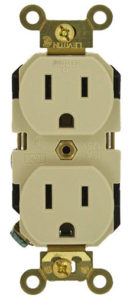 |
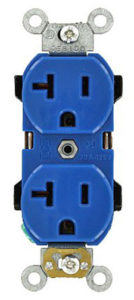 |
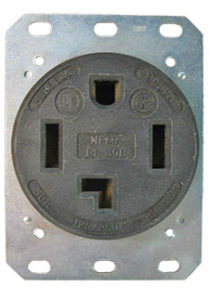 |
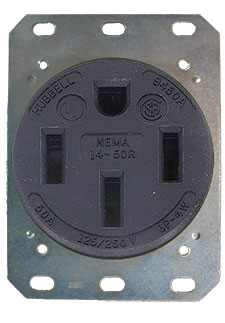 |
| Leviton 120V 15A (#5262 NEMA 5-15) |
Leviton 120V 20A (#5352 NEMA 5-20) |
Hubbell 240V 30A (HBL9430A NEMA 14-30) |
Hubbell 240V 50A (HBL9450A NEMA 14-50) |
Q: Where can I obtain adapters and other charging accessories that Tesla does not make?
A: There are several 3rd party companies that specialize in charging accessories for electric cars. Here are a few we know of:
Q: I am buying/have bought a Tesla Wall Connector and wish to plug it into an existing outlet rather than hardwire the unit to the electrical panel. I know I won’t get the maximum charge rate for my Model 3 with the long-range battery, but I don’t need the maximum charge rate. Can do?
A: Yes! The Wall Connector has a dial that lets you configure it for the circuit amperage you are plugging into. You can simply order a cord that matches the outlet type. Let’s say you have a NEMA 14-50 outlet. That is a 50 amp, 4-wire outlet, so you would need a 50 amp, 4-wire cord.
NEC code requires the cord to be under 1 foot in length.
Q: I just have a standard 120V 15A socket in my garage, which according to your chart only charges the battery at 4-5 miles of range per hour. Is there any way I can charge at a higher rate without having to re-wire my garage?
A: Possibly. You might be able to convert the circuit that the outlet is connected to from a 120V circuit to a 240V circuit without the need to upgrade the wiring between the breaker box and the outlet. This only works if the desired outlet is the ONLY outlet on the circuit to the breaker box, a somewhat rare situation. You’ll also need to switch wires to a new 240V dual breaker. You need two open adjacent slots for a 240V 2-pole breaker. Keep in mind you free up one breaker slot used by the current outlet.
This change boosts the charging speed to 11 mrph. Because only the voltage is increasing, not the current, the wiring can remain as is. Use an electrician and permit when making this change. The existing NEMA 5-15 outlet(s) connected to the circuit needs to be replaced with a single NEMA 6-15 outlet such as this industrial-grade Leviton 5651 model seen here:
Q: I just have a standard 120V 20A socket in my garage, which according to your chart only charges the battery at 6-7 miles of range per hour. Is there any way I can charge at a higher rate without having to rewire my garage?
A: The same answer as above except you need a 240V 20A outlet. That is a NEMA 6-20. Here is an example of an industrial-grade Leviton 5461 outlet.
Q: What do I need to know when hiring an electrician?
A: The first thing you need to know is that all electricians are not created equal! Skill levels and attention to detail, even among licensed electricians, vary widely. Choosing an electrician is sort of like choosing a mate… you don’t just take the first one that happens along. Be cautious. Use your “I’m a good consumer” skills when interviewing an electrician. Here are some tips:
- Tesla has an Electrician referral service. This is not a panacea, just a starting point. The caveat here is that the price quote may be higher than those of other electricians. People across the board report that prices are higher when the word “Tesla” is mentioned.
- Go to an electrical supply house. Avoid a big box store like Home Depot or Lowes. An actual electrical supply distributor that has a retail counter. These guys know all the local electricians and may be able to give you a quality recommendation.
- Regardless of how you source the electrician, ask for references. Check Yelp.
- Get multiple quotes. This cannot be overstated. Each electrician has their point of view, and prices naturally vary. Don’t go with the lowest bid. Ask questions. Go with the person who also asks you good questions, seems most capable, and provides references.
- Know what you are talking about before you call. That’s what this guide is for. If you’re having an outlet installed be familiar with the model numbers of the industrial version of that outlet. Ask specifically for an industrial-grade outlet or order it yourself in advance. See if the electrician balks or seems confused by the question. Stipulate the use of COPPER wire. Don’t accept aluminum wire. If the electrician won’t comply with your wishes send them packing.
- If you’re installing an outlet consider claiming it is for an RV, not an EV. It is widely reported that electricians charge more to wire up outlets for electric cars. Especially Tesla vehicles!
Q: Do I need to buy a second Mobile Connector for when I travel? I like keeping the one that came with the car plugged in at home. It’s too much hassle removing it from the trunk and uncoiling it every day. And I read the caution about constantly plugging and unplugging the cord.
A: It depends. Keep in mind that you don’t need the Mobile Connector to use Superchargers or Destination Chargers. And you can carry just the J1772 adapter which allows you to plug into 3rd party charge stations that employ the J1772 standard. That covers a lot of ground. However, if you’re the type that likes being ready for anything, an extra Mobile kit may come in handy. If you’re ever low on charge near an RV park or campground, the 50A NEMA 14-50 adapter or a TT-30 adapter (see next FAQ) could come in handy. If you’re ever visiting friends or relatives you can at least trickle charge the battery in their driveway. That means it’s good to have the 15A 5-15 and 20A 5-20 adapters with you. In cold climates, such a connection keeps the battery warm.
Before purchasing a second Mobile Connector for $300, take another look at the Tesla Wall Connector for $500. For the extra $200 you get the advantages of the Wall Connector noted above. Or consider swapping out your home outlet for an industrial model, as noted earlier in the FAQ section.
Q: Are there any other adapters I should travel with besides the ones that come with the Mobile Connector?
A: Yes. Some RV parks have special 120V 30A outlets that accommodate travel trailers and smaller RVs. The outlet type is called a TT-30. Tesla does not make an adapter for this outlet, but EVSE Adapters used to sell a TT-30 adapter. Check if it is still available.
Q: Why can’t I charge my car as fast as at a Supercharger or Destination Charger?
A: You can charge at home at least at the same speed as a Destination Charger. Destination Chargers are just Tesla Wall Connectors. Your car has a built-in charger that maxes out at 32 amps for the standard-range battery and 48 amps for the long-range battery. If the Wall Connector is wired to at least a 60-amp circuit (either your home unit or at a hotel), it charges the car at the maximum rate (44 mph for the long-range battery and 30mph for the standard-range battery). Be advised that the Wall Connector can be installed on any circuit from 15 to 100 amps and charge the car accordingly. So, in that sense not all Destination Chargers are equal. It all depends on what amperage circuit the unit was installed on.
Note: A single Wall Connector charging one car only requires a 60-amp circuit and breaker to charge the long-range battery at the maximum rate (32 amps for the standard-range battery). If using multiple Wall Connectors (up to 4) you can install them on a single circuit up to 100A and the units load share to make maximum use of the power and allow all the cars to charge uniformly.
A Supercharger bypasses the onboard charger in the car to supply high-power direct current (DC) directly to the battery. When using household power, the car’s onboard charger converts household alternating current (AC) into DC which the battery requires.
Q: What is it that determines how much power the car tries to draw?
A: Good question! It is important that the car never draws more current than the electrical circuit is rated for. Normally this happens automatically. It is the adapters that came with the car in the Mobile Connector kit (or purchased from Tesla) that determine how much current to draw. Let’s say you are charging from a 20A outlet. You would, therefore, plug one end of the 20A NEMA 5-20 adapter into the outlet, and the other end into the Mobile Connector (which then plugs into the car). The adapter signals the onboard charger to draw no more than 16A. The code requires no more than 80% of a circuit to be utilized for continuous loads.
The Tesla adapter signals the proper rate of charge for the outlet type it is connected to. Knowing this helps keep you from getting into trouble when looking for special adapters that violate power limits to connect with unusual outlets. These 3rd party adapters, ostensibly designed to work on a Tesla, may break the normal rules and could overload a circuit.
Here’s an example: Cathy wants to go camping in her Tesla. She is staying at an RV park that does not have the typical 240V 50A NEMA 14-50 outlets for RVs. They only have lower-powered outlets for small RVs. The outlet is called a TT-30 (for Travel Trailer) and is 120V, 30A. Tesla does not make an adapter for a TT-30 outlet. However, a company called AC WorksTM has made an after-market TT-30 adapter that uses the Tesla-supplied 14-50 adapter to allow plugging into the TT-30 outlet. This is problematic. The fact that the 3rd party adapter uses the Tesla 14-50 adapter means that the car thinks it is plugged into a 240V 50A outlet when it is a 120V 30A outlet! At best this means a tripped circuit breaker (the car tries to draw 32 amps on the circuit, which is the maximum current the Gen 2 Mobile Connector allows). Not recommended!
The suggested workaround for such a kludgy setup is to use the car’s charging screen to manually dial back the charging rate to 24 amps. This is not wise because it is too easy to forget to do so. The better solution when looking for outlet adapters that Tesla does not make is to find a company that makes an adapter that plugs directly into the Mobile Connector and signals the exact right amperage to draw. EVSE Adapters is one company that may have what you need.
Q: I have heard of a product on eBay called Dryer BuddyTM that lets you share a dryer outlet with your EV. Is this thing worth a damn? I occasionally use my dryer in the garage.
A: It can be. But buy the right version! Otherwise, you end up with a “Cathy the camper” problem as described in the prior question. One version of the Dryer Buddy requires you to use your 50A 14-50 adapter to plug into a 30A outlet! Your 14-50 adapter tells the car it is plugged into a 50A outlet, and if you don’t override the amperage limit setting on the car’s charging screen, the breaker will trip. That is if everything goes as it should… otherwise, house wires dangerously overheat and catch fire!
To explain how to purchase the correct version of the Dryer Buddy here is an excerpt from a forum thread discussing the product. Member “Rocky_H” responds to a member leaning toward buying the version that comes with a 50A 14-50 socket.
“… You talked about getting Dryer Buddy #4. I recommend against people doing that. It’s a bad idea. First off, it’s not even the right outlets you’re talking about. The #4 version plugs into a 10-30 in the wall and splits it into a 10-30 and a 14-50. So, you would be plugging into a 14-50 outlet on it with the Tesla charging cable. That’s a really bad idea for your regular daily charging scenario. If you forget to turn down the amps in the car or if it resets from a software update or something (that happens sometimes), then you are overdrawing the circuit, and you need to hope the breaker trips. So definitely don’t get that version, which puts a 50-amp outlet type on a 30-amp circuit. The one you might want would be the one that plugs into a 14-30 (if that’s the outlet in your wall) and just duplicates it to two 14-30 outlets.
Furthermore, if people are going to use a Dryer Buddy, I only recommend using the PLUS AUTO versions. They have sensing and auto-switching in them to make sure you don’t accidentally have both outlets drawing at the same time, which (again) would have to rely on your breaker tripping. So if you get the proper one with two 14-30 outlets in the PLUS AUTO version, it’s about $295.
Oh, and the ordering website for the Dryer Buddy products is weird and confusing. They don’t list all the versions of the products. You must select it in two parts to get one item. You pick the Dryer Buddy version with the outlets you want, add that to your cart ($143), and then you also add the upgrade to the PLUS AUTO as a separate item ($152).”
Q: You state the maximum speed I can charge with the Gen 2 Mobile Connector is from 5 to 30 miles of range per hour using an outlet. I need faster charging on the road due to very long days on the highway, and my route doesn’t take me near a Supercharger. I do have access to a 14-50 outlet. I understand the original Gen 1 Mobile Connector does not have the 32-amp limit the Gen 2 MC has. If I had a Gen 1 MC could I charge faster from that 14-50?
A: You have a very unusual situation but there is a solution. Tesla used to offer al Corded Mobile Connector that plugs into a 14-50 outlet and used ones might be available. It does NOT allow different adapters to be used though! There is simply a fixed 14-50 plug permanently attached to the end of the cable that allows the car to charge at 40A or 37 mrph, which is nearly 20% faster than what the standard Mobile Connector allows.
Levity Q: We have solar / are intending to install solar. No batteries though. Too finicky. It seems like it is best to charge the car during the day when we have the most excess power. Except, the car’s not here during the day! What’s a greenie to do?
Levity A: OK. This is a nice can of worms you have opened. Let’s start with the simple, easy-to-digest worms first. If your solar is NOT tied to the grid, you have few options. Solar power is a use-it-or-lose-it thing unless you have a way to store all that photonic energy.
You could concoct various contraptions to store the energy for when your car needs it. If you live in a wooded area you could strip all the branches off the trees and have a circular platform loaded with rocks that are raised to the treetops during the day via solar-powered motors. At night the platforms would be released, and they would create power via regen on the same electric motors to charge your car. Or you could use the daytime solar output to heat all your neighbor’s swimming pools via a complex underground piping system, and then use thermo-electric couplers to draw the heat from the pools at night to create enough electricity to charge your car.
Or instead, we would take a page from Neo’s book ‘The Matrix’:
For now, batteries are still the most economical way to store electrons. And for battery storage, the Tesla Powerwall is an incredible value. Compared to a do-it-yourself system –sourcing the lithium-ion cells, charge controller, inverter, battery management, all the odd wires and pieces, and the time to assemble everything– a Powerwall not only has all those parts fully integrated, it costs about half the DIY approach. We’re not kidding here. We’ve run the numbers against a real DIY system, and kilowatt for kilowatt the version 2 Powerwall is about 50% less expensive.
Now if you have installed a grid-tied solar system it’s a whole different ballgame. Grid-tied means you are connecting the solar inverter (the thing that turns DC from the solar panels into AC to run the house) to the electric utility, and you have the potential to sell power to the utility. So effectively you use the utility company as a “battery”. You sell the power generated by your panels during the day, then buy the power back at night when your car charges. The tricky part is the rate you sell your power for, vs. the rate, you pay to buy it back. That is where the big worms come in and understanding the ever-evolving games the utilities are playing with rate plans for this scenario is really a guide unto itself. So that’s as far as we can take it. Our best recommendation to charge your car at the best possible rates with grid-tied solar is to read up on net metering, and net metering vs. net billing, and then investigate what your local utility is offering.
- Tesla – Home charging
- Tesla – Electrician referral
- Tesla – Buying a Mobile Connector
- Tesla – Buying adapters not included with the Mobile Connector kit
- Good forum post about electrician costs #1
- Good forum post about electrician costs #2
- TeslaTap’s Supercharger Superguide
- Home Charging Wiring Guide
- Acronyms and Abbreviations to help in decoding terminology.
- EVSE Adapters – 3rd party adapters for electrical outlets that Tesla does not have an adapter for. These adapters are recommended because they properly signal the car to charge at the appropriate rate.
- Electrek article on Model 3 charging options
- Extension cable – Type 2 (Europe)
- Wiki article on NEMA outlet standards
- NEMA outlet identifier chart
